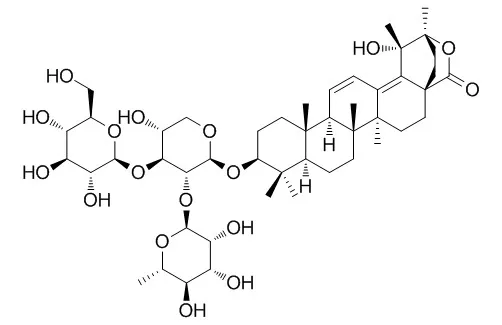Kuding tea are used as a traditional tea material and widely consumed in China.
METHODS AND RESULTS:
In this study, total saponins (TS) from water extract of Kuding tea was prepared by D101 macroporous resins and analyzed by UPLC-QTOF-MS/MS. Then the hypolipidemic effect of TS extract was investigated in high-fat diet-induced hyperlipidemic mice. For comprehensive identification or characterization of saponins in TS extract, 3 major saponins of Kudinoside A, Kudinoside F, and Kudinoside D were isolated and used as standards to investigate the MS/MS fragmentation pattern. As a result, 52 saponins were identified or characterized in TS extract from Kuding tea. In addition, the increased levels of mice serum TC, LDL-C, HDL-C, and atherogenic index (AI) were significantly reduced after the treatment of TS extract. Also, the liver protective effect of TS extract was obviously judged from the photographs stained with oil red-O staining. Meanwhile, TS extract significantly upregulated the expression of hepatic scavenger receptors including SR-AI, SR-BI, and CD36. Therefore, it is reasonable to assume that the overexpression of hepatic scavenger receptors was involved in the hypolipidemic effect of Kuding tea on the high-fat diet-induced hyperlipidemic mice. The TS extract could influence these scavenger receptors, and this could be the potential mechanism of TS extract from Kuding tea in the treatment of lipid disorders.
CONCLUSIONS:
These results give the evidence that the saponins in Kuding tea could provide benefits in managing hypercholesterolemia and may be a good candidate for development as a functional food and nutraceutical. |






 Cell. 2018 Jan 11;172(1-2):249-261.e12. doi: 10.1016/j.cell.2017.12.019.IF=36.216(2019)
Cell. 2018 Jan 11;172(1-2):249-261.e12. doi: 10.1016/j.cell.2017.12.019.IF=36.216(2019) Cell Metab. 2020 Mar 3;31(3):534-548.e5. doi: 10.1016/j.cmet.2020.01.002.IF=22.415(2019)
Cell Metab. 2020 Mar 3;31(3):534-548.e5. doi: 10.1016/j.cmet.2020.01.002.IF=22.415(2019) Mol Cell. 2017 Nov 16;68(4):673-685.e6. doi: 10.1016/j.molcel.2017.10.022.IF=14.548(2019)
Mol Cell. 2017 Nov 16;68(4):673-685.e6. doi: 10.1016/j.molcel.2017.10.022.IF=14.548(2019)